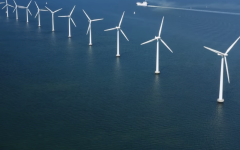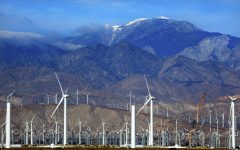
Offshore Wind farm. (Photo: Energy.ca.gov)
Offshore Wind Energy-Cost and Economic Impacts: Part 2
Electricity grids need batteries that can store as much as a month’s demand, and then discharge that energy over the course of six months or more
By Robert Sidenberg, April 30, 2024 2:45 am
This is Part II of Offshore Wind Energy: The Cost and Economic Impacts; Part I is here.
The Golden State’s electricity prices are the second highest in the country, with only Hawaii’s costs being greater.
Contrary to what the public is being told offshore wind energy is the most expensive and inefficient way to produce electricity. The unprecedented amount of subsidies for wind and solar energy distort the wholesale energy market causing overall electricity prices to increase to unprecedented levels. This is mostly due to wind and solar’s intermittency problem and its reliance on conventional peak power sources like nuclear and natural gas to fill the void at times of low or no wind or sun. When these peak power sources are not able to operate continuously as they were designed they are less inefficient resulting in more fuel being consumed, more CO2 emissions released, and increased operating costs.
Storage
To cover this intermittency problem, wind and solar facilities need to be backed up by something. It is apparent fossil-fuel generators are not a consideration although neither is nuclear, which would actually be the best solution if the true goal is to reduce CO2 emissions. Of course we could simply build a few more nuclear power plants and there would be no need for inefficient large scale wind or solar generators, problem solved. But since we have ignorant and/or corrupt politicians in government mandating the conversion to intermittent renewable sources of energy, some form of storage will be needed. But the amount of storage needed and the cost has not been adequately addressed. Currently there is no storage solution that can fully replace wind and solar’s intermittent period at any cost nor is there any real solution in the near future.
There are plans for energy storage using batteries but in all cases the capacity that could be delivered by year 2030 is at the most .2% of the amount needed. Recent government reports on the projected cost and capabilities of battery technologies using even the most optimistic assumptions, show the cost to be as high as a country’s annual GDP. Current battery technologies provide about four hours of discharge at maximum capacity, but based on various weather patterns, grids need batteries that can store as much as a month’s demand, and then discharge that energy over the course of six months or more. Such ‘long duration’ batteries have not yet been invented.
“Green” hydrogen is another highly subsidized proposed alternative storage medium produced by electrolysis of water. The high cost of this production tax credit subsidy is equivalent to $91 per megawatt-hour (MWH) which is much greater than the wholesale electricity prices in the U.S., which in 2023 averaged between $30/MWh and $50/MWh.
Francis Menton, in his report “The Energy Storage Conundrum” writes:
“Politicians and governments have committed their people to Net Zero goals without any kind of demonstration project that shows that the goal can be achieved technologically, let alone at reasonable cost. To date, no such project has achieved Net Zero emissions through intermittent renewable generation and energy storage backup; nor is there anything close to it. Half-hearted efforts to build such demonstration projects have incurred unaffordable costs, without getting close to the Net Zero goal, leaving no reason to think that such a system can ever succeed.”
“The push toward Net Zero without a fully demonstrated and costed solution to the energy storage conundrum is analogous to jumping out of an airplane without a parachute, and assuming that the parachute will be invented, delivered and strapped on in mid-air in time to save you before you hit the ground. Now, before our advanced economies are destroyed, it is time to demand from our politicians and energy planners that they level with the public about the huge costs and the likely impossible technical requirements of the goals to which they have committed us.”
Curtailment
As wind and solar subsidies affect overall electricity prices by over producing electricity during periods of low demand, this creates congestion in the grid which causes it to overheat. To prevent this another subsidy, “curtailment” is provided. Curtailment entails paying some wind and solar generators to not produce during these periods. The price paid to curtail often exceeds the price to produce.
Power Purchase Agreements
As previously mentioned California, like many other states that subsidize wind energy companies, do so through Power Purchase Agreements. PPA’s set an agreed upon price that wind companies say they need to be paid for their projects to be viable. The agreements force the utility companies or the state to pay, but either way the consumer is on the hook. We need to realize that when Federal and State governments shell out all this money in subsidies it is actually we the American tax-payer footing the bill. The high electricity rates we pay each month is only a small portion. The additional hidden costs are in the numerous fees and taxes we are forced to pay. When energy is expensive everything else becomes expensive. It’s a huge tax on everything.
The Grid
A reliable and affordable electrical power grid system is crucial to the economy and security of the United States. Without it we are vulnerable in many ways. The current policies mandated by our federal and state governments are unquestionably threatening to the stability of the grid. Shifting transportation, heating, and other essentials onto the grid is increasing electricity demand exponentially, further straining an energy infrastructure that is being pushed to the brink. Further more one of our most basic freedoms, “free to choose” is threatened when we have only one source of energy and that is controlled by the government.
Please contact all your city, county, state, and federal government representatives, and tell them to oppose all offshore wind energy projects built along the California coast. Although our local city officials and county supervisors have no direct authority to stop this they influence others by announcing their opposition. We all need to push hard against all these elected officials and if they ignore us they need to be removed and replaced.
Sources:
- Offshore Wind Energy-Cost and Economic Impacts: Part 2 - April 30, 2024
- Offshore Wind Energy: The Cost and Economic Impacts Part 1 - April 16, 2024
- Green Energy Destroying California’s Coast: Morro Bay Wind Farm Project - January 14, 2024





Bottom line???
Offshore wind energy is an ABSOLUTELY DISASTROUS suggestion, which is probably why the dipwad Democrats in Excremento want to pursue it…. it’s “feel good” pie-in-the-sky ideation that has ZERO basis in reality and will actually HARM the eco-system….